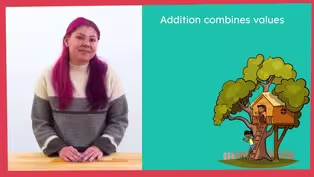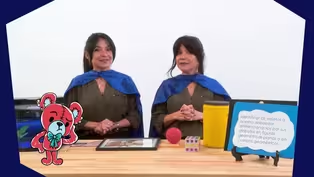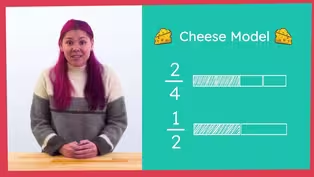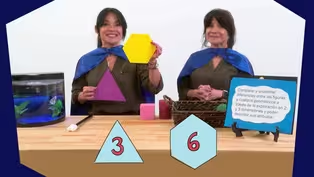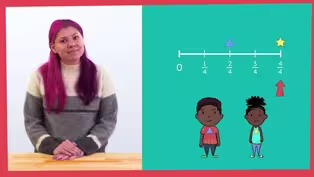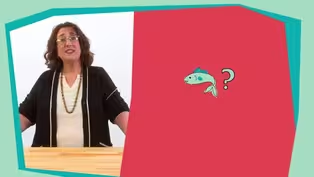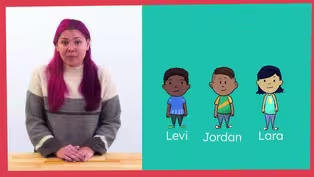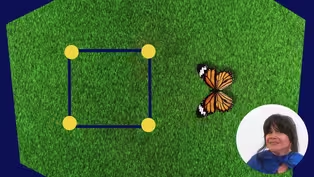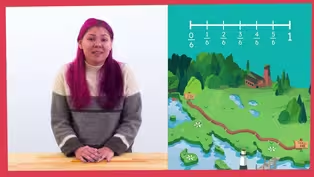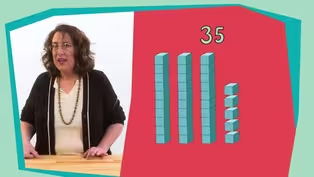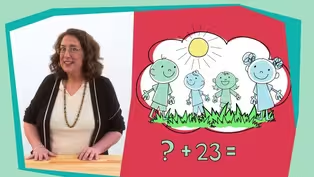
Episode 37 | Math Lessons
5/3/2021 | 28m 46sVideo has Closed Captions
Math lessons for early learners, led by NC teachers.
The first lesson (aimed at PreK-K learners) uses drawing and concrete materials to represent mathematical ideas. The second lesson (aimed at 1st-2nd graders) teaches students how to represent and solve addition and subtraction word problems. Classroom Connection is your At-Home Learning companion where children love to learn. All lessons are led by NC educators.
Problems playing video? | Closed Captioning Feedback
Problems playing video? | Closed Captioning Feedback
At-Home Learning Presents: Classroom Connection is a local public television program presented by PBS NC

Episode 37 | Math Lessons
5/3/2021 | 28m 46sVideo has Closed Captions
The first lesson (aimed at PreK-K learners) uses drawing and concrete materials to represent mathematical ideas. The second lesson (aimed at 1st-2nd graders) teaches students how to represent and solve addition and subtraction word problems. Classroom Connection is your At-Home Learning companion where children love to learn. All lessons are led by NC educators.
Problems playing video? | Closed Captioning Feedback
How to Watch At-Home Learning Presents: Classroom Connection
At-Home Learning Presents: Classroom Connection is available to stream on pbs.org and the free PBS App, available on iPhone, Apple TV, Android TV, Android smartphones, Amazon Fire TV, Amazon Fire Tablet, Roku, Samsung Smart TV, and Vizio.
Providing Support for PBS.org
Learn Moreabout PBS online sponsorshipMore from This Collection
Math lessons for early learners, led by NC teachers.
Video has Closed Captions
Math lessons for early learners, led by NC teachers. (28m 46s)
Video has Closed Captions
Math lessons for early learners, led by NC teachers. (28m 46s)
Video has Closed Captions
Math lessons for early learners, led by NC teachers. (28m 46s)
Video has Closed Captions
Math lessons for early learners, led by NC teachers. (28m 46s)
Video has Closed Captions
Math lessons for early learners, led by NC teachers. (28m 46s)
Video has Closed Captions
Math lessons for early learners, led by NC teachers. (28m 46s)
Video has Closed Captions
Math lessons for early learners, led by NC teachers. (28m 46s)
Video has Closed Captions
Math lessons for early learners, led by NC teachers. (28m 46s)
Video has Closed Captions
Math lessons for early learners, led by NC teachers. (28m 45s)
Video has Closed Captions
Math lessons for early learners, led by NC teachers. (28m 46s)
Video has Closed Captions
Math lessons for early learners, led by NC teachers. (28m 45s)
Video has Closed Captions
Math lessons for early learners, led by NC teachers. (28m 46s)
Providing Support for PBS.org
Learn Moreabout PBS online sponsorship[cheerful upbeat music] ♪ - What up cool cats?
Did you know that there are 293 ways to make change for a dollar?
Yeah, math helps you make change for a dollar, and count the coins you might've found between the couch cushions.
So let's start your math lesson now, and see what we can learn.
[bright upbeat music] - Hello, super learners.
I'm Ms. L, and I am so glad you're joining me today.
Are you ready for a math adventure?
Look, let's get started with a song.
♪ Hello super learners, how are you ♪ ♪ Hello, super learners, how are you ♪ ♪ I'm so glad you're here today ♪ ♪ and I hope you feel the same ♪ ♪ hello super learners, how are you ♪ Oh, I feel great today, and I really, really hope you do too.. Well, now it's actually time for some math power warmups.
We're gonna count to 20.
Are you ready?
Here we go, come on.
♪ one, two, three, four, five, six, seven, eight, ♪ ♪ nine, 10, 11, 12, 13, 14, 15, 16, 17, 18, 19, 20 ♪ ♪ That was fun.
♪ Wow, great job, counting to 20.
Now let's count up to 20 one more time.
We're gonna do some snap counting.
Can you snap with me?
Let's do it, ready?
One, two, three, [snapping] four, five, six, [snapping] seven, eight, nine, [snapping] 10.
Let's keep going.
11, 12, 13, [snapping] 14, 15, 16, [snapping] 17, 18, 19, [snapping] 20.
Yes super learners are the best, and you really are super learners.
You are best.
I'm feeling warmed up, are you?
Well, how about one more time counting to 20?
But this time I'd like for us to sing in Spanish.
Can we say our numbers to 20 in Spanish?
Let's do it.
[speaking in foreign language] 20, great job super learners.
You know, we have counted to 23 different ways.
Awesome job.
Now let's review our colors but let's say them in English and in Spanish, ready?
[speaking in foreign language], red, [speaking in foreign language], orange, [speaking in foreign language], yellow, [speaking in foreign language], green, [speaking in foreign language], blue, [speaking in foreign language], purple, [speaking in foreign language], brown, [speaking in foreign language], black, [speaking in foreign language], white, [speaking in foreign language], gray.
Look for these colors in the world today.
Awesome job super learners.
We have one more warmup.
So let's play the shapes game.
I love this game.
You we'll see the shape.
And then you say its name in English or in Spanish.
All right, here we go.
[speaking in foreign language], square, [speaking in foreign language], circle, [speaking in foreign language], triangle, [speaking in foreign language], rectangle, [speaking in foreign language], rhombus, [speaking in foreign language], trapezoid, [speaking in foreign language], hexagon, [speaking in foreign language], cube, [speaking in foreign language], cone, [speaking in foreign language], cylinder, [speaking in foreign language], spear.
Great job, so many shapes.
Are you feeling all warmed up?
I am too.
I think it's time for our math mission of the day.
You know who we get our mission from?
Sparkles the fish.
Let's check in with sparkles to see what our mission is today.
Sparkles, what do you have for us?
You have a special mission?
All right, let's see what it is.
I love these missions.
Let's see what it says.
This looks important.
It says, dear super learners in your mission today, you are to compose numbers 11 to 19 as groups of 10 and ones.
I know we can do this mission, let's see.
To get ready for our mission, we know what we need to do.
I need my super cape.
So let's get my cape.
Can you put on your invisible Cape too?
Let's see.
Whenever I wear my Cape, I feel like I can do any math mission and especially with your help.
My Cape is on and I'm ready.
Are you ready?
Math power up, let's go.
Oh, wait.
Before we begin, I remember sparkles telling me we have a special math tool today.
This is our 10 frame.
It's made of 10 blocks.
Let's check to make sure.
I always check and count before just to make sure there's actually 10, let's see.
One, two, three, four five, six, seven, eight, nine, 10, awesome.
So we have five on top, one, two, three, four, five, and five on the bottom, one, two, three, four, five.
That's all awesome.
So this special math tool, it's called the 10 frame, and it really helps us quickly see how many blocks are filled and how many are empty.
So on our first math mission today we will see just how helpful this tool really is.
So let's get to our first mission, and I think it's right in front of me.
I love snowflakes.
This is our snowflake challenge.
I need your help figuring out just how many we have.
They're all on the table, but we need to count them.
These are a lot of snowflakes.
So whenever we have a big number that's where our 10 frame really comes in handy.
So help me count these as we place them on the frame, ready?
We'll start with number one, number two, three, four, five, six, seven, eight, nine, 10.
We build up the 10 frame.
So far we have 10 snowflakes.
Now we need to count the snowflakes that are left over.
Oh my goodness look.
We have one, two snowflakes left.
This means that we have 10 and two, 10 and two.
We'll start them over here.
I wonder how many that is.
I think we should just keep counting.
We know we have 10, so we'll say 11, 12.
We have 12 snowflakes, 10 and two equals 12.
Great thinking super learners.
I'm so glad we were able to count these beautiful snowflakes.
For this next mission, I need your help super learners.
I need your help counting how many snowmen I have, with green scarves and how many I have with purple scarves.
We know that there are 15 snowmen total but we need to separate them first into groups by color, before we start counting.
So I think we should put our green snowmen here, and our purple snowmen here.
Can you help me with that?
Awesome.
First, what color is this?
It's green, that's right.
So we'll put our green ones here.
And then what color is this one?
Purple, awesome.
We'll put this here.
So now help me as I sort these.
Green here, purple here, green here, another green one, and another green, oh, here's a purple one, and then a green, another green snowman, awesome, purple.
Well, we have a lot of green snowmen.
Oh my goodness.
And then here's our purple.
Awesome job.
So now it's time to count.
We're gonna count our green snowmen first.
It looks like it is the largest group.
So we're gonna put them into groups.
We don't have our trusty 10 frame, but we can work with our snowmen like we would with our 10 frame.
So we're gonna put them in groups of five first.
So we'll do a row of five here, and a row of five there.
So we'll start counting, ready?
One, two, three, and four, and five.
Here's our first row.
We have some more snowmen.
So let's start another row.
We'll do one, and two, and three, four ,and five.
So we have five here and five there.
Let's see.
This means we have 10, five and five equals 10.
So let's write our number 10.
So we don't forget.
We have 10 green snowmen, 10.
Now it's time to do our other group.
Let's do our group of purple snowmen.
So we'll start with a group of five just like we did before.
One, two, three, four, and five.
Look, that's all of our purple snow men.
That means that we have five, five purple snowmen, total.
And this tells us that we have 15 snowmen altogether.
So that must mean that 10 and five is 15.
Awesome job super learners.
Great work.
Five plus 10 equals 15.
So there are so many ways to take numbers apart and put them back together.
It's called composing and decomposing numbers.
We did it super job super learners.
So I think we're finished.
But first, what do we have to do?
We have to check in with Sparkles the fish.
Let's see if we've completed our mission.
Hey, sparkles, are we finished?
We are, mission complete.
Congratulations super learners, you used your math powers and completed the missions today.
So before we go, what do we need to do?
Review.
So we know how to build and take apart numbers.
With the help of a 10 frame or just by grouping our numbers.
So I think you can practice at home.
You can practice building numbers today and share your math power by showing it to someone.
So thank you super learners for going on this math mission with me, and a special thank you to sparkles the fish.
Thank you so much.
I hope you have a super day, [speaking in foreign language] friends, bye.
- We've been having so much fun today learning from teachers and each other.
And now we have a very special video of someone about your age reading one of their favorite books.
I just love this one, and I know you will too.
[bright upbeat music] - Hi, my name is Sela, and I'm gonna read, Who Said Moo?
Early every morning, Red Rooster went to the top of the barn.
He flapped his wings and crowed, cock-a-doodle do, cock-a-doodle do.
[cock crows] Usually no one answered.
Not anyone.
But on this sunny morning, someone said, moo.
[cow moos] [bright upbeat music] Red Rooster asked a plump pig, "someone said moo, was it you?"
"I don't moo," answered the pig.
"I oink."
[pig grunts] Red Rooster met a spotted dog.
"Someone said moo, was it you?"
"I don't moo," answered the dog.
"I woof."
[dog barks] Red Rooster met a grey donkey.
"Someone said moo, was it you?"
"I don't moo," answered the donkey.
"I hee-haw."
[donkey brays] Red Rooster followed a tabby cat.
"Someone said moo, was it you?"
"I don't moo," answered the cat.
"I meow."
[cat meows] Red Rooster ran after a black sheep.
"Someone said moo, was it you?"
"I don't moo," said the sheep.
"I baa."
[sheep bleat] Red Rooster saw a spotted cow.
"Someone said moo, was it you?"
"Yes," said the cow.
"I said moo."
"And I moo, too," said her baby calf.
Meow, cock-a-doodle do, woof, baa, oink, moo, moo, hee-haw, meow, the end.
[bright upbeat music] - Hey, did you know an ostrich's eye is bigger than their brain?
You know what's bigger than your brain?
Your brain after this math lesson.
Let's get into it.
[bright upbeat music] - Hi friends, my name is Dawn, and I'm so happy to be here with you today.
This is my friend Splat, and he is going to help me today with some math fun.
Today we are going to solve a problem about sharing with a friend.
It's very kind to share with your friends.
Before we begin, let's take some time to gather some supplies.
Let's get something to write with, paper or whiteboard and a stuffed animal or a trusted adult.
I'll wait here while you gather any supplies you need.
[bright upbeat music] Welcome back.
Let's get started.
My friend Moesha, always shares.
She is going to share cherries with her friend Jacob.
Here's a picture of Moesha's cherries.
Today, you, Splat and I are going to read a mathematical story about Moesha and her cherries that she is going to share with her friend Jacob.
Your job today is to figure out how many cherries Moesha has after she shares with Jacob.
Let's read a little to find out about Moesha and her cherries.
But wait, before we get started, let's exercise our brain and get it ready to do some math work so we can be fit mathematicians.
Will you join me?
Let's stand up and let's find five objects in your house.
I'll wait here.
[bright upbeat music] Do you have your five objects?
Nice, let's count them together.
One, two, three, four, five.
Now let's take three objects away.
One, two three, awesome.
So we started with five objects, and then we took three away, so how many do we have left?
That's right, we have two, one, two.
Five objects take away three objects, is two.
Now let's do it again.
Let's find six objects in your house.
I'll wait here.
[bright upbeat music] I just grabbed my six objects.
Do you have your six objects?
Great job, let's count them together.
One, two, three, four, five, six.
Now let's take two of our objects away.
One, two.
So we started with six objects, and then we took away two.
So how many do we have left?
You're right, we have four.
Because six objects take away two objects is four.
One, two, three four.
Wow, I feel energized and ready to focus on helping Moesha figure out how many cherries she has.
Let's get ready to read our story.
Our story says, Moesha has some cherries in her basket.
Moesha gives some cherries away to her friend Jacob.
What are you picturing in your mind?
I'm picturing Moesha with cherries in a basket, and her sharing some with her friend Jacob.
How many cherries could Moesha have?
Tell a friend or trusted adult how many cherries you think Moesha has.
That's right.
She could have four, nine or 12.
We don't know how many.
Now tell someone else or a stuffed animal how many cherries Moesha could have given to Jacob?
[bright upbeat music] Yes, Moesha could have given two, 13 or 19 cherries to Jacob.
Let's read a little more about Moesha.
Moesha has 13 cherries in her basket.
Moesha gives some cherries away to her friend Jacob.
What do we know now that we didn't know before?
That's right.
We now know that Moesha has 13 cherries.
How many cherries do you think Moesha could have given to Jacob?
Write down on paper or your whiteboard and show Splat and me, how many cherries you think Moesha gave away?
[bright upbeat music] That's great.
I see some awesome predictions of the number of cherries Moesha gave away.
Seven or three or maybe nine, let's keep reading.
Moesha has 13 cherries in her basket.
Moesha gives six cherries away to her friend Jacob.
What do we find out now that we didn't know before?
You're right.
We now know that Moesha gave six cherries to her friend Jacob.
What question could we ask about this math story?
Let's think of a question about Moesha and her cherries, and share your question with the trusted adult or stuffed animal, and then whisper it to Splat and me.
[bright upbeat music] I'm listening for the whispers.
[bright upbeat music] I hear a whisper that says we could ask, how many more cherries does Moesha have than Jacob?
That's a great question.
[bright upbeat music] I hear another whisper that says, how many cherries does Moesha have left?
These are great questions.
Let's read a little more about Moesha.
Moesha has 13 cherries in her basket.
Moesha gives six cherries away to her friend Jacob.
How many cherries does Moesha have left?
What is the question in our story?
Yes, you're right.
The question is asking the total amount of cherries Moesha has after sharing with Jacob.
[bright upbeat music] Do you you have all the information you need to answer that question?
Yes, you do have all the information you need.
I want you to think about how you can solve this problem.
Tell a trusted adult or stuffed animal, how you would solve this problem.
Splat always helps me solve math stories.
Splat just told me a way that I can solve this problem.
Splat says we can use a tool called a 10 frame.
Let's try it out.
We will use two 10 frames to find out how many cherries Moesha has left.
We are going to fill the 10 frames with the amount of cherries that Moesha has before she shares with Jacob.
How many cherries does Moesha have before she shares?
Yes, she has 13.
So let's fill our 10 frames with 13 counters to represent our 13 cherries.
I know that if one 10 frame is all filled that means I have 10.
And I can count on from 10 to the other 10 frame until I get to the number 13.
Count with me, 10, 11, 12, 13.
Let's do it one more time.
Start at 10, 11, 12, 13.
Great job.
We have all of Moesha's cherries own our 10 frame.
Let's figure out how many cherries she has left after she shares six with Jacob.
We need to get rid of six of the cherries on the 10 frame to represent the six cherries she gave away to Jacob.
Count with me as I cross off, Jacob's six cherries that Moesha gave him.
One, two, three, four, five, six.
Great job friends.
What do you notice?
[bright upbeat music] I notice the same.
I see that there are seven cherries left.
That means we figured out that Moesha has seven cherries left after sharing with Jacob.
That is a great job friends.
You've done such a great job of solving the mathematical story of how many cherries Moesha has left.
We used a 10 frame tool to help us decide that Moesha has seven cherries left.
In a bit we're going to talk about another way to solve this problem.
But let's take a math movement break before we do.
I would like to invite you to stand up for this math movement break.
A number will appear on the screen.
That number is the number of jumps we should do.
Ready?
Here we go.
Nine, let's do nine jumps.
One, two, three, four, five, six, seven, eight, nine.
Four, let's do four jumps.
One, two, three, four.
Great job.
Now let's do two jumps.
One, two, fantastic.
Let's do seven.
One, two, three, four, five, six, seven.
Let's do five, One, two, three, four, five.
And finally let's do three, one, two, three.
That was some great jumping.
It's great to exercise our math brains and bodies.
Are you ready to solve this story another way?
I know I am.
Remember our math story was Moesha had 13 cherries.
She shared six cherries with Jacob.
How many cherries does she have left?
Splat and I are going to show you another way to solve this story problem other than with the 10 frame.
Splat says we can draw a picture to help us solve.
We could draw a picture of 13 cherries, then we could cross out six of the cherries, and we'd have seven cherries left.
The equation we might write to go with that story could look like this.
13 minus six equals seven.
[bright upbeat music] Great job solving that problem.
Friends, Splat and I have to be going now.
We had so much fun with you today.
You worked so hard to solve our mathematical story using 10 frames and pictures to help you subtract.
Splat and I hope you enjoy today, and we hope to see you soon.
[bright upbeat music] - I love my dance move, do you all like my dance moves?
Y'all like my dance moves.
I may not be able to dance, but I know my man Hose can help break it down for you.
Check it out.
- Hey everyone, it's your boy Hose here, and today we're gonna be learning another hip hop step.
Today's step comes from break dancing, and we're gonna be covering a basic top rock.
This is a really easy step so I want everyone to follow along.
We're gonna start off by hopping, feet together, hands coming up in this position on the one, then I want you to cross step over your foot two, now as you cross that, I want you to bring your hands up just like this.
Good job, nice one.
Now, I want you to bring it back, one, cross it to the other side two.
Nice work, bring it back.
And we're just following the same way over and over.
Here on the one, stepping out on the two, here on the one, stepping out on the two.
If we put on one, two, count to it.
This is one, two, one, two, and the drums.
[imitates drumming] There you go.
Nice, make sure you practice, practice, practice, and I'll see you kids on the next one, peace.
- For more information, please visit pbsnc.org/AHL.
- This is your captain speaking, you ready lift off?
♪ I'm all learning ♪ [bright upbeat music] ♪ Yeah, from the classroom through history and others face ♪ ♪ to dinosaurs and habitats from another place ♪ ♪ to the big bang and matter in every state ♪ ♪ thank goodness for this time, right at home ♪ ♪ I'm all learning.
♪ [Cheerful upbeat music] ♪


- Home and How To

Hit the road in a classic car for a tour through Great Britain with two antiques experts.












Support for PBS provided by:
At-Home Learning Presents: Classroom Connection is a local public television program presented by PBS NC
